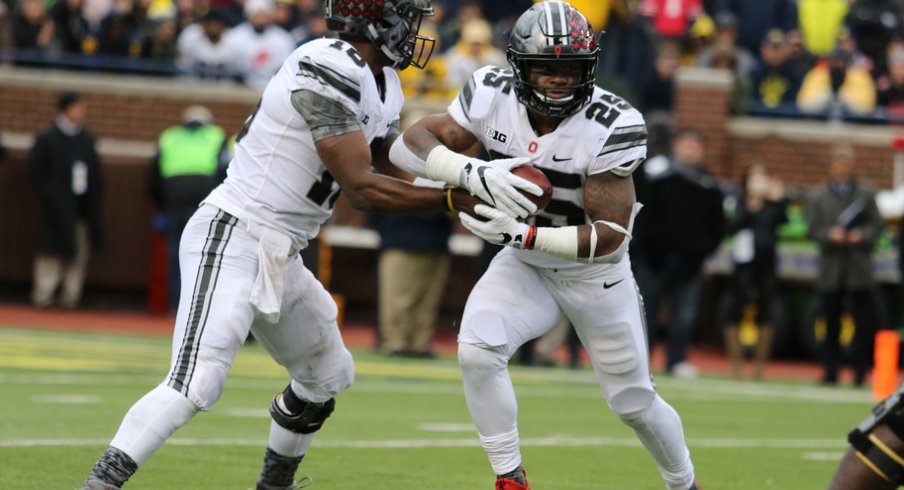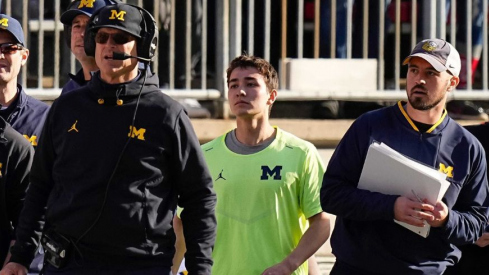Favored by two touchdowns heading into the 114th playing of The Game, many expected the matchup between the Ohio State offense (ranked fourth nationally in yards-per-game) and the Michigan defense (ranked third in yards allowed) to be a stalemate in a low-scoring contest, with the Buckeyes leaning on their own defense to be the difference. By looking at the box score, this prediction mostly held true, as Ohio State steadily outgained their rivals and forced a late turnover that sealed an 11-point road victory.
But the box score alone fails to tell the Jekyll and Hyde story of the Buckeye offense that afternoon in the Big House, as the visitors from Columbus failed to gain a single positive yard in the first quarter before completely flipping the script in the three subsequent periods. While many have claimed the injury to J.T. Barrett and subsequent performance of Dwayne Haskins turned the tide in this contest, the truth is Urban Meyer and his offensive staff had already cracked the nut of Don Brown's defense by that point in the game.
Despite both coaches downplaying their teams' ability to surprise one another at this point in the season, the crafty Brown came out with an unexpected game plan that was quite different from last year's contest and threw the Buckeyes off-balance. Though his teams have always run a variety of coverages, Brown's Michigan defense had leaned heavily on man-coverage throughout this season.
However, as the Buckeyes looked to pass early in the game, they saw an abundance of two-deep zones on early downs, like this Tampa-2 zone that easily corralled the underneath passing concepts expected to break open against man-coverage:
But on third-and-long, Brown went back to man concepts, yet again breaking tendencies by dropping seven players in coverage and only sending four rushers.
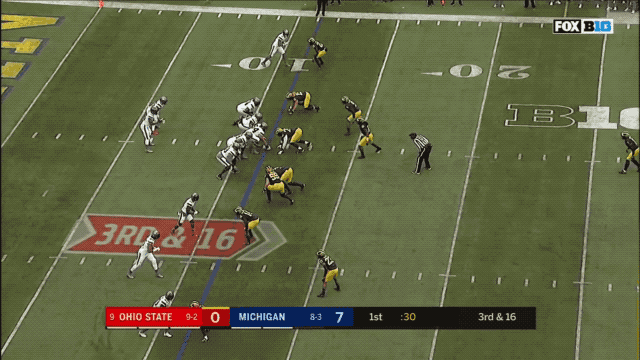
This Cover-1 Robber look relied on the Wolverine defensive backs to lock up Buckeye wideouts one-on-one, and left a Robber in the middle of the field (often the middle linebacker) to act as a spy for J.T. Barrett, should he take off and run. As a result, Barrett had nowhere to go with the ball and was forced to take multiple early sacks.

But Brown had one more trick up his sleeve, using a trap coverage that looks initially like a regular Cover-2 zone to one side of the field, but is really a pattern-matching defense to the other. The advantage of this look is it frees up the boundary cornerback to attack the flats, taking away the relief routes like arrows or bubble screens that the Buckeyes add as extensions to the running game.

As James A. Light, a close follower of Brown's tactics called out early in the game, the Wolverines were regularly running 2 Trap on early downs. This asked the safety and outside linebacker to the trap side to cover receivers vertically while the corner played a sight technique, allowing him to get eyes in the backfield immediately.
Michigan/Don Brown OLB Trap coverage assignment pic.twitter.com/rYo6lPk9Ev
— James Light (@JamesALight) November 25, 2017
Though the Buckeyes were initially thrown off by Michigan's heavy use of this concept, Barrett was able to get points on the board by scrambling as the defense was too busy ensuring their coverage responsibilities to have eyes in the backfield as the play unfolded.
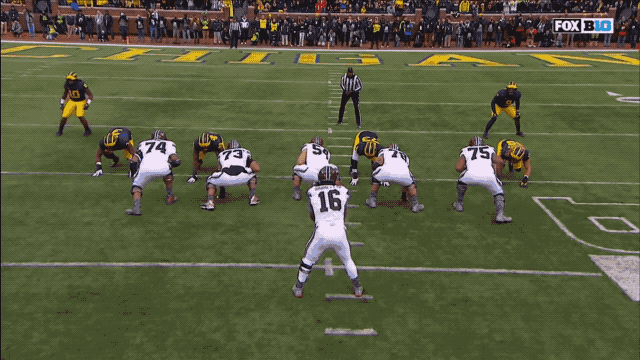
For the most part, though, the Buckeye offense wasn't fooled by Brown's tactics once they were identified and instead had to overcome execution errors of their own.
In an effort to neutralize star end Rashan Gary, Ohio State often tried to read him in the option game. But as seen in the Sweep Read example below, although Barrett made the proper read on Gary, handing off to Parris Campbell for a Jet Sweep, hybrid linebacker Khaleke Hudson easily knifed between two blocks and made an easy tackle for loss.
But the Buckeyes would use the Wolverines' aggressiveness against them, dialing up play-action off the same backfield action and springing tight end Marcus Baugh open up the seam as Hudson failed to carry out his responsibility in the 2 Trap coverage.
This pattern would repeat itself throughout the afternoon, as plays that had failed to work in the first quarter all of sudden sprung open for big gains in the second. For instance, this QB counter run was dead-on-arrival as center Billy Price slipped after pulling to lead Barrett outside on the keeper.
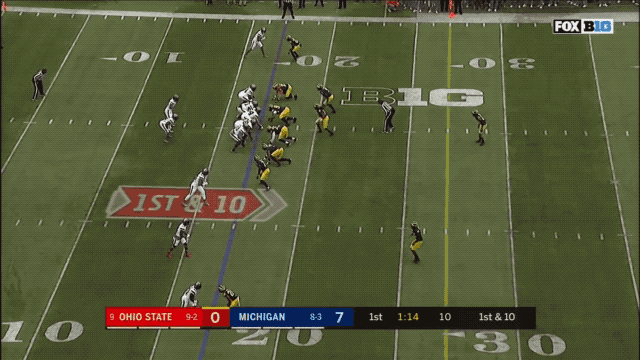
But when Price was able to keep his feet, the same play led to a wide open hole, as the Buckeyes had numbers to the boundary while Michigan continuously lined up in an Over front with extra defenders to the field.
Although they'd only throw 15 times, the Buckeyes made similar strides to get out of their own way in the passing game. Though Haskins completed two crossing routes to K.J. Hill in the fourth quarter on drives that eventually ended in points and sealed the victory, he was helped out by a coaching staff that made necessary adjustments as the game progressed.
As they have all season, the OSU game plan called for a heavy dose of Mesh, the crossing concept that can now be hidden in every formation in Meyer's playbook. Expecting to see man-coverage, though, coordinators Kevin Wilson and Ryan Day added a swing route to the running back in hopes of catching a speedy player like J.K. Dobbins in the flat against linebacker Mike McCray, who had struggled to cover Saquon Barkley on similar concepts earlier in the year.
But to ensure McCray would be the player in coverage, the Buckeyes would have to run the swing pattern to the boundary, leaving McCray in a great position to make the tackle on Hill's crossing route, should the ball go there instead. So, in the second half, the Buckeyes called the play from a modified, empty formation that split the back out to the field, clearing plenty of space for Hill's crosser.
Of course, this game was won on the ground, as has been the case in all six of Meyer's victories over his biggest rival. The Buckeyes would look to option Gary in a number of ways, building their game plan entirely around neutralizing him in the run game and leading to 226 rushing yards - the most Michigan has allowed all season.
Though the Wolverines put their defensive line in an Over front to the field, the linebackers were left to protect the backside run gaps. But by adding simple motion from the H receiver, the linebackers shifted to the field as well, leaving the Buckeyes with adequate blocking numbers to the backside and springing running backs J.K. Dobbins and Mike Weber for some solid gains.
Both backs did an excellent of making defenders miss, but were given the chance thanks to the work of the big boys in front of them.
Once Haskins entered the game for the injured Barrett, the game plan became more constricted, as the coaches clearly tried to simplify things for their backup QB. The running game relied far more heavily on called runs to Dobbins and Weber, removing the option aspect on concepts like Power-O.
But the Buckeyes had clearly planned on running the ball outside, and although they'd called for variations on the Sweep Read throughout the game, the read aspects were removed for Haskins in favor of simple Buck Sweeps that Michigan clearly wasn't expecting.
While the Buckeyes didn't rely on formation wrinkles as much as they had in previous weeks, they clearly had a game plan meant to neutralize Michigan's best player and get their athletes the ball in space. Though they took a dramatic path to get there - deciphering the opposing game plan, failing to execute in the first quarter, and eventually losing their starting quarterback - the game plan put together by Meyer and his staff largely delivered.
Just probably not as they'd planned.
